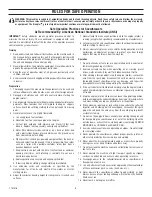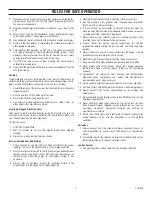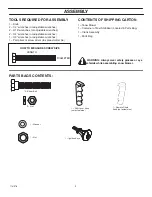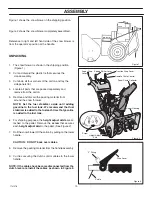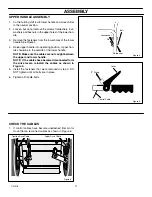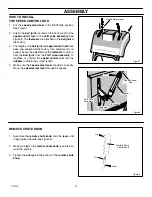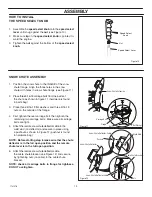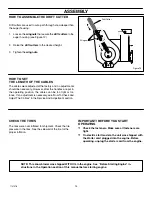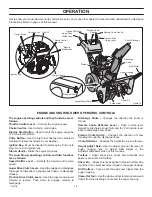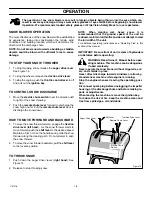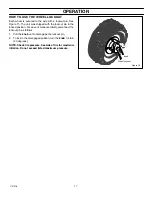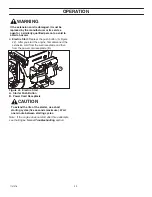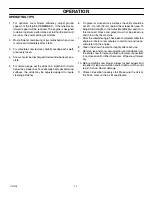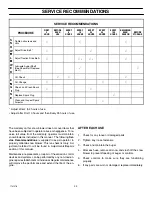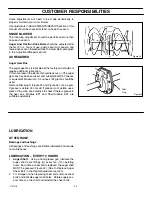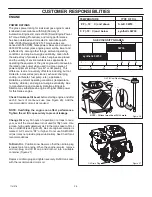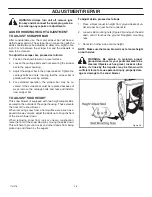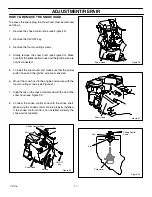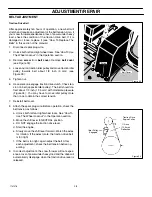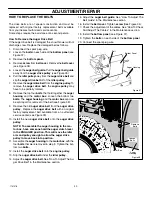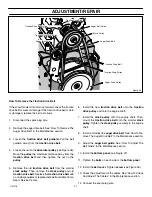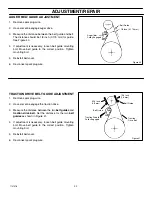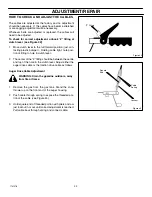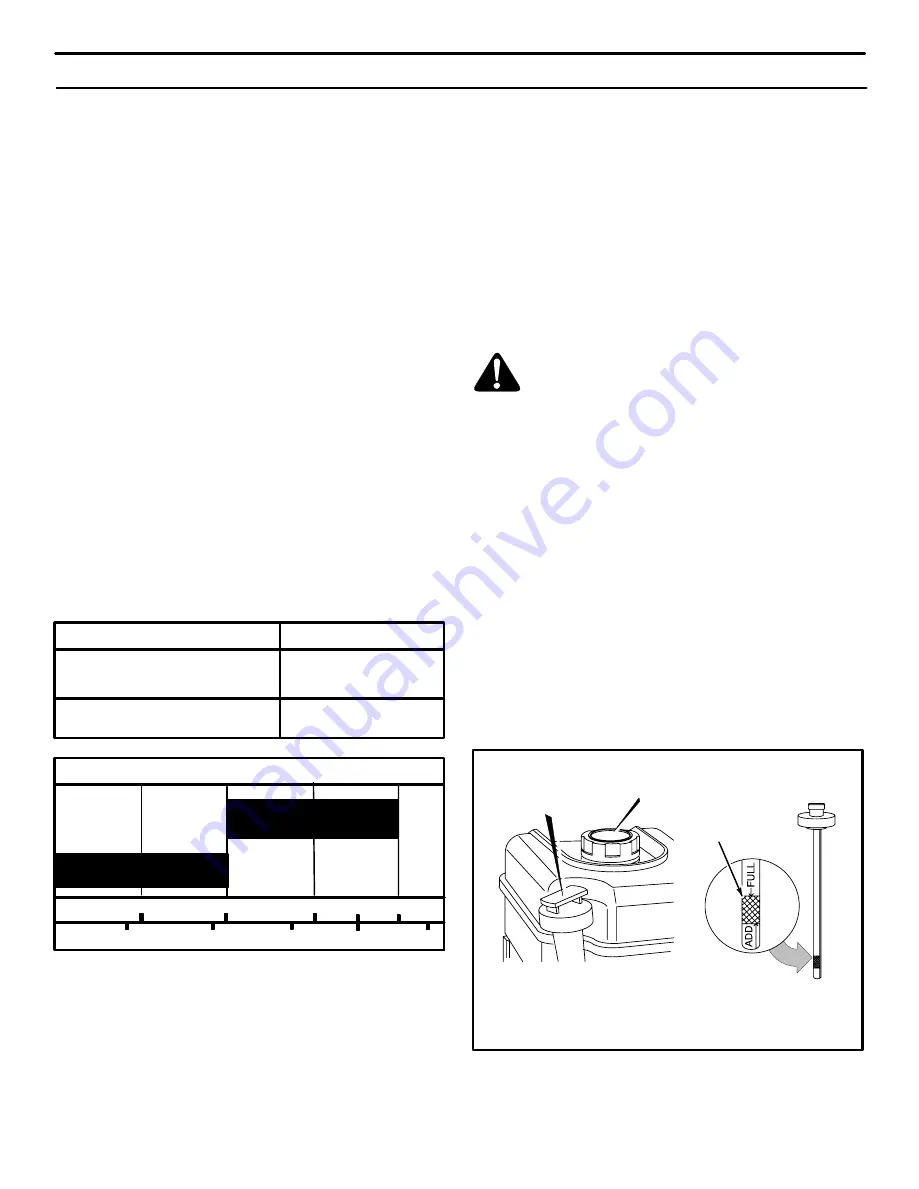
OPERATION
18
1741078
BEFORE STARTING ENGINE
Check the oil
NOTE: The engine was shipped from the factory filled
with oil. Check the level of the oil. Add oil as needed.
1. Make sure the unit is level.Use a high quality detergent
oil classified “For Service SG, SH, SJ, SL, or higher”.
2. Remove the oil fill cap/dipstick and wipe with a clean
cloth (see Figure 16).
3. Insert the oil fill cap/dipstick and turn clockwise to tighten.
4. Remove the oil fill cap/dipstick and check the oil.
NOTE: Do not check the level of the oil while the
engine runs.
5. If necessary, add oil until the oil reaches the FULL mark
on the oil fill/cap dipstick (see Figure 16). Do not add too
much oil.
6. Tighten the fill cap/dipstick securely each time you check
the oil level.
NOTE: For extreme cold operating conditions of 0
F
(
−
18
C) and below, use a synthetic 5W30 motor oil for
easier starting.
NOTE: S.A.E. 5W30 motor oil may be used to make
starting easier in areas where the temperature is 20
F.
(
−
7
C) to 0
F (
−
18
C). Synthetic 5W30 is acceptable for
all temperatures. DO NOT mix oil with gasoline.
NOTE: SEE CHART FOR OIL RECOMMENDATION
0
F (
−
18
C) and below
0
F (
−
18
C) and above
TYPE OF OIL
TEMPERATURE
synthetic 5W30
S.A.E. 5W30
F
−
20 0 20 32 40
C
−
30
−
20
−
10 0 10
SAE VISCOSITY GRADES
5W30
synthetic 5W30
FILL GAS
This engine is certified to operate on gasoline. Exhaust
Emission Control System: EM (Engine Modifications)
1. Fill the fuel tank with fresh, clean, unleaded regular, un-
leaded premium, or reformulated automotive gasoline
with a minimum of 85 octane along with a fuel stabilizer
(follow instructions on fuel stabilizer package).
DO NOT
use leaded gasoline. We recommend that fuel stabilizer
be added to the fuel each time that gasoline is added to
the fuel tank.
NOTE: Winter grade gasoline has higher volatility to
improve starting. Be certain container is clean and
free from rust or other foreign particles. Never use
gasoline that may be stale from long periods of
storage in the container.
CAUTION: DO NOT use gasoline containing any
amount of alcohol as it can cause serious damage to
the engine or significantly reduce the performance.
2. Check to make sure that spark plug is tightened securely
into engine and spark plug wire is attached to spark plug.
If torque wrench is available, torque plug to 18
−
23 ft
−
lbs.
WARNING: Gasoline is flammable. Always use
caution when handling or storing gasoline. Do
not add gasoline to the fuel tank while snow
blower is running, hot, or when snow blower is in an en-
closed area. Keep away from open flame, electrical
sparks and DO NOT SMOKE while filling the fuel tank.
Never fill the fuel tank completely; but fill the fuel tank
to within 1-1/2 inch (3.8 mm) from the top to provide
space for the expansion of the fuel. Always fill fuel tank
outdoors and use a funnel or spout to prevent spilling.
Make sure to wipe up any spilled fuel before starting
the engine.
Store gasoline in a clean, approved container, and keep
the cap in place on the container. Keep gasoline in a
cool well ventilated place; never in the house. Never
buy more than a 30 day supply of gasoline to assure
volatility. Gasoline Is intended to be used as a fuel for
internal combustion engines; therefore, do not use
gasoline for any other purpose. Since many children
like the smell of gasoline, keep it out of their reach be-
cause the fumes are dangerous to inhale, as well as be-
ing explosive.
FULL
Figure 17
Oil Fill Cap/Dipstick
Fuel Tank
BEFORE STOPPING THE ENGINE
Run the engine for a few minutes to help dry off any moisture
on the engine.
Summary of Contents for 6331790-43 Series
Page 37: ...NOTES 37 1741078...
Page 38: ...NOTES 38 1741078...



